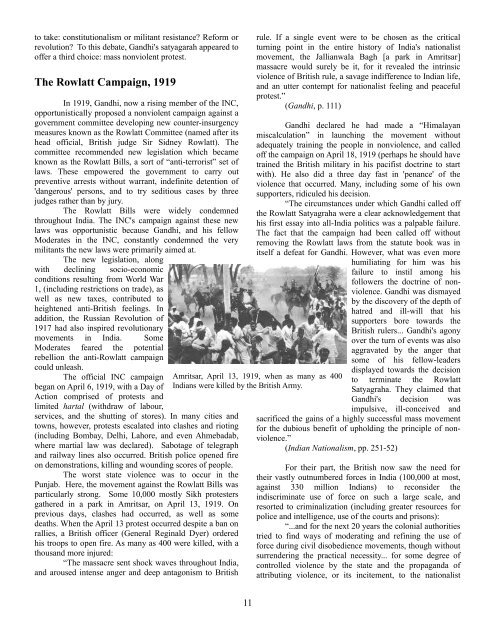smash-pacifism-zine
smash-pacifism-zine
smash-pacifism-zine
You also want an ePaper? Increase the reach of your titles
YUMPU automatically turns print PDFs into web optimized ePapers that Google loves.
to take: constitutionalism or militant resistance Reform or<br />
revolution To this debate, Gandhi's satyagarah appeared to<br />
offer a third choice: mass nonviolent protest.<br />
The Rowlatt Campaign, 1919<br />
In 1919, Gandhi, now a rising member of the INC,<br />
opportunistically proposed a nonviolent campaign against a<br />
government committee developing new counter-insurgency<br />
measures known as the Rowlatt Committee (named after its<br />
head official, British judge Sir Sidney Rowlatt). The<br />
committee recommended new legislation which became<br />
known as the Rowlatt Bills, a sort of “anti-terrorist” set of<br />
laws. These empowered the government to carry out<br />
preventive arrests without warrant, indefinite detention of<br />
'dangerous' persons, and to try seditious cases by three<br />
judges rather than by jury.<br />
The Rowlatt Bills were widely condemned<br />
throughout India. The INC's campaign against these new<br />
laws was opportunistic because Gandhi, and his fellow<br />
Moderates in the INC, constantly condemned the very<br />
militants the new laws were primarily aimed at.<br />
The new legislation, along<br />
with declining socio-economic<br />
conditions resulting from World War<br />
1, (including restrictions on trade), as<br />
well as new taxes, contributed to<br />
heightened anti-British feelings. In<br />
addition, the Russian Revolution of<br />
1917 had also inspired revolutionary<br />
movements in India. Some<br />
Moderates feared the potential<br />
rebellion the anti-Rowlatt campaign<br />
could unleash.<br />
The official INC campaign<br />
began on April 6, 1919, with a Day of<br />
Action comprised of protests and<br />
limited hartal (withdraw of labour,<br />
services, and the shutting of stores). In many cities and<br />
towns, however, protests escalated into clashes and rioting<br />
(including Bombay, Delhi, Lahore, and even Ahmebadab,<br />
where martial law was declared). Sabotage of telegraph<br />
and railway lines also occurred. British police opened fire<br />
on demonstrations, killing and wounding scores of people.<br />
The worst state violence was to occur in the<br />
Punjab. Here, the movement against the Rowlatt Bills was<br />
particularly strong. Some 10,000 mostly Sikh protesters<br />
gathered in a park in Amritsar, on April 13, 1919. On<br />
previous days, clashes had occurred, as well as some<br />
deaths. When the April 13 protest occurred despite a ban on<br />
rallies, a British officer (General Reginald Dyer) ordered<br />
his troops to open fire. As many as 400 were killed, with a<br />
thousand more injured:<br />
“The massacre sent shock waves throughout India,<br />
and aroused intense anger and deep antagonism to British<br />
rule. If a single event were to be chosen as the critical<br />
turning point in the entire history of India's nationalist<br />
movement, the Jallianwala Bagh [a park in Amritsar]<br />
massacre would surely be it, for it revealed the intrinsic<br />
violence of British rule, a savage indifference to Indian life,<br />
and an utter contempt for nationalist feeling and peaceful<br />
protest.”<br />
(Gandhi, p. 111)<br />
Gandhi declared he had made a “Himalayan<br />
miscalculation” in launching the movement without<br />
adequately training the people in nonviolence, and called<br />
off the campaign on April 18, 1919 (perhaps he should have<br />
trained the British military in his pacifist doctrine to start<br />
with). He also did a three day fast in 'penance' of the<br />
violence that occurred. Many, including some of his own<br />
supporters, ridiculed his decision.<br />
“The circumstances under which Gandhi called off<br />
the Rowlatt Satyagraha were a clear acknowledgement that<br />
his first essay into all-India politics was a palpable failure.<br />
The fact that the campaign had been called off without<br />
removing the Rowlatt laws from the statute book was in<br />
itself a defeat for Gandhi. However, what was even more<br />
humiliating for him was his<br />
failure to instil among his<br />
followers the doctrine of nonviolence.<br />
Gandhi was dismayed<br />
by the discovery of the depth of<br />
hatred and ill-will that his<br />
supporters bore towards the<br />
British rulers... Gandhi's agony<br />
over the turn of events was also<br />
aggravated by the anger that<br />
some of his fellow-leaders<br />
displayed towards the decision<br />
to terminate the Rowlatt<br />
Satyagraha. They claimed that<br />
Gandhi's decision was<br />
impulsive, ill-conceived and<br />
sacrificed the gains of a highly successful mass movement<br />
for the dubious benefit of upholding the principle of nonviolence.”<br />
(Indian Nationalism, pp. 251-52)<br />
Amritsar, April 13, 1919, when as many as 400<br />
Indians were killed by the British Army.<br />
For their part, the British now saw the need for<br />
their vastly outnumbered forces in India (100,000 at most,<br />
against 330 million Indians) to reconsider the<br />
indiscriminate use of force on such a large scale, and<br />
resorted to criminalization (including greater resources for<br />
police and intelligence, use of the courts and prisons):<br />
“...and for the next 20 years the colonial authorities<br />
tried to find ways of moderating and refining the use of<br />
force during civil disobedience movements, though without<br />
surrendering the practical necessity... for some degree of<br />
controlled violence by the state and the propaganda of<br />
attributing violence, or its incitement, to the nationalist<br />
11



